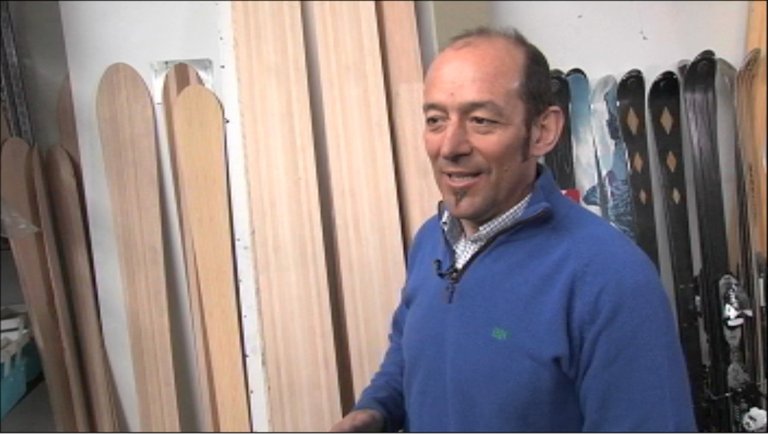Skis Made in Astigarraga

NAGORE REMENTERIA; Elhuyar: The ski season is over and now the backworks begin: the preparation of the material for the next season. And in Astigarraga you have a workshop and you do skis by hand here. How did you get started on this?
GURUTZ CORETTI; Coretti ski: I started making skis for myself. I couldn’t find a favorite in the market. It was not difficult because of my work I knew the CAD-CAM manufacturing systems, I knew the epoxy resins, I also knew the rapid prototyping... I was more or less familiar with the technology of producing skis, not knowing how they were made, but it is learned through testing.
NAGORE REMENTERIA; Elhuyar: And how do you make a pair of skis?
GURUTZ CORETTI; Coretti ski: It starts from the wooden core for skiing, it is the soul of skiing and it is very important to work well. It is very much cared for in handmade skis, not so in conventional skis. Complete wooden slats are used in handmade skis.
In the case of N. A. is: What wood do you use for skis?
According to G. The C.: We use birch, ash and shepherd. We mix woods with different behavior, of different densities, to dampen the forces between them. For example, here we have birch and ash. Birch and ash boards are glued together to make a half ski. We cut four sheets and stuck them open in the mirror. In this way, the ski is symmetrical and both are the same. In both cases, the veins are the same. Factory skis, however, are made with slatted boards, i.e. the boards have joints and are not symmetrical. Skis don’t come out the same and have to measure and make pairs.
Although handcrafted, new technologies such as CAD design and mechanized CAM can be used.
In the case of N. A. is: What does computer design bring to a pair of handmade skis?
According to G. The C.: Computer-aided design offers flexibility. I can design a ski adapted to the person, the skier. The process begins with the design of the ski, with a three-dimensional design program the geometry of the ski is designed, the dimensions, the turning radius, the thicknesses. The characteristics of the ski will depend on it: its hardness and the way it is skied.
In the case of N. A. is: What's the next step, Gurutz?
According to G. The C.: We have the sole cut and we twist the steel edges to adapt them to the shape of the sole and we glue them once with a temporary adhesive.
In the case of N. A. is: What is the function of this border?
According to G. The C.: The Hertz helps to grip the snow on very hard snow and ice. This is the main reinforcement that I use, almost nobody uses it. We use carbon fiber to strengthen the wooden core, we choose the orientation of the fiber according to the forces it must withstand. Carbon has a force in the direction of the fiber. This unidirectional fiber has strength in one sense, biaxial in two senses. This is +45/-45, and this is 0/90. This fiber has strength in this sense and in this one, not in this.
I choose one mold or another depending on the length of the ski, I have everything. We'll put the pieces on top of the mold. We'd put the soles first. The two skis are made together to be identical. We would apply epoxy resin on the sole and carbon on top. Impregnate with epoxy and the wooden core. Cover with carbon again with fibers in different directions and impregnate with epoxy. We then covered it with a porous fabric to allow excess resin to come out, and over it an absorbent blanket.
In the case of N. A. is: And now comes a crucial moment.
According to G. The C.: Yes, now we will close the mold with a vacuum bag: it is a plastic film with an adhesive mastic. The whole is covered and glued to the mould so that it is completely closed and then evacuated. The vacuum bends the wood core to assume the shape of the ski at its rear and front ends; and will draw excess resin through the porous fabric to the absorbent blanket. This minimizes the amount of resin remaining in the carbon.
In the case of N. A. is: How long does it take?
According to G. The C.: It must be kept under vacuum in the oven for 15 hours at 45 degrees in order to properly catalyze the epoxy resins.
In the case of N. A. is: and is it already?
According to G. The C.: So far, it's time to go out and cut... Layers of resin on top of each other... Once the ski surface is finished, protections, accessories and fixings are installed.
Buletina
Bidali zure helbide elektronikoa eta jaso asteroko buletina zure sarrera-ontzian











